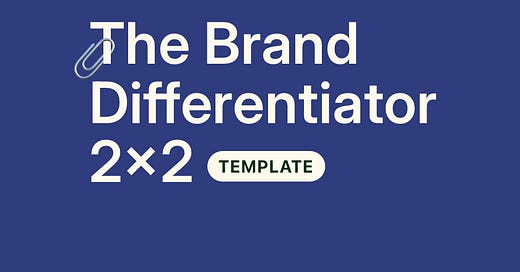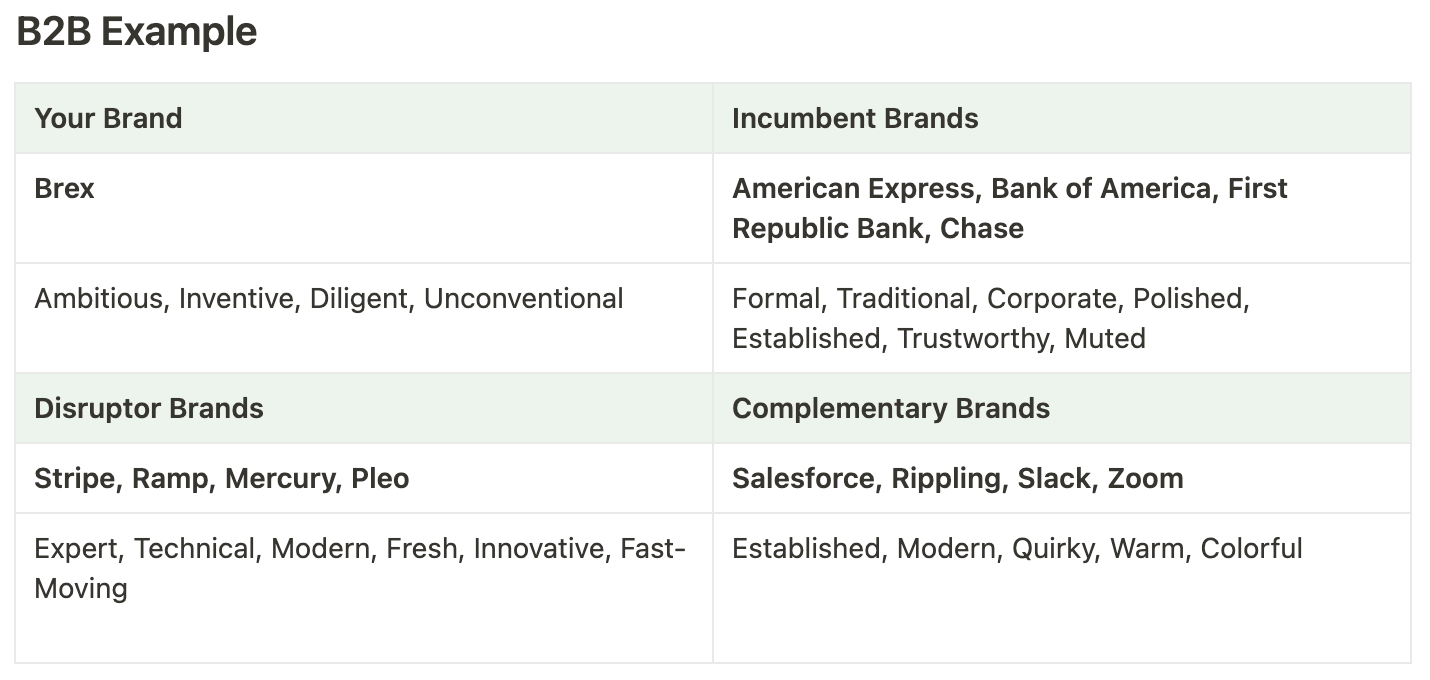Greetings from 30,000 feet—I’m flying back from an onsite in 32°F Boston as I share this write-up on my favorite, unfussy template for brand differentiation.
On a (somewhat?) related topic, how do you get buy-in from founders who want to control everything (but clearly need your help)? How do you push for brand investment, let alone convince them their baby needs a glow up? 😬
Next Wednesday, March 5 (9-10am PT, 12-1pm ET), join me for a virtual talk, Building a Founder-Led Brand, hosted by B2B creative agency Shaped By.
And if you’re looking for more on that topic, then you’ll definitely get good use out of 10 Brand Rules for Founders and How to Get Brand Buy-In. See you there!
You’re here because you recently subscribed or signed up for one of my resources—my course waitlist on Maven, lightning lesson, or Notion templates.
If someone sent you this post and you’re not subscribed, join those people learning how to tactically advocate for brand at your company. 📬
When I was at Brex building our core brand strategy, we needed a simpler way to understand (and visualize) how our brand personality would stand out from both legacy players and fellow disruptors. The 2×2 we developed became a cornerstone for shaping our differentiated position in the market, and helped us balance the key tension between revolution and trust—the latter being an imperative when you’re handling other people’s money.
I’m sharing this template because it’s since become one of my most reliable tools for helping teams develop distinctive brand personalities that actually resonate in their market. It’s easy to digest, and that’s what makes it effective. Whether you’re refreshing an existing company identity or building a new one, this framework helps you make sure you’re not just ~different,~ but different in ways that matter.
What the 2×2 does
This framework maps your brand & product against three key categories:
Incumbent/legacy brands that dominate market share; they typically have high awareness, well-established perceptions
Disruptor/challenger brands who challenge the status quo and disrupt the landscape with a new offering or approach; their awareness levels and strength of related perceptions may vary
Complementary brands your audience uses alongside yours (integrations, part of the same tech stack) and associates yours with (brands in related but distinct categories)
Why it works
Your brand doesn’t exist in a vacuum. The magic of this framework is that it forces helps you think about brand personality in context.
Understanding the incumbent, disruptor, and complementary contexts where your brand exists helps you identify brand traits and adjectives that can occupy a white space and will genuinely differentiate your brand. Even better, using this approach will help you avoid the trap of adopting personality traits that sound (kinda) good but don’t actually help you stand out, or mean much to your audience (ahem, “innovative”).
For your audience, who is no doubt savvy and discerning (especially you B2B brands out there—we’re weary and waiting to be impressed), it’s not enough to say “we want to be bold and innovative.” You need to understand how that positions you relative to others in your space.
When we first filled in this 2×2 at Brex, it revealed that while most fintech disruptors were leaning into being “modern” or “expert,” there was blank space for a brand that could be both bold (in product approach and aesthetic) while deeply credible. This insight eventually shaped everything from our visual identity to our tone of voice.
How to use the 2×2 effectively
Start by mapping 3-5 key brands in each category, collecting specific examples (get that FigJam going) of how their personality shows up in their:
Visual identity
Tone of voice
Marketing campaigns
Product experience
Customer communications
Take screenshots of webpages, emails, social media feeds and posts (including their execs’ and employees’), billboards, swag, and all the ways the brand identity is expressed.
As you develop traits for your own brand’s quadrant, look for opportunities to differentiate meaningfully. But don’t just be different for different’s sake. The traits you choose need to:
Resonate with your target audience
Are these traits they would actually value?
Does your audience want to see themselves this way?
Feel authentic to your company culture
Does your team already exhibit this trait or behavior—to some degree?
If you rolled these out tomorrow, how much internal convincing would it take? (This isn’t to say you can’t enact a major change, but it’s good to be aware how much internal culture and company philosophy would need to change, too.)
Be sustainable as you scale
Where do you want to be 5 years from now? Will your audience be the same then? Or will you be much farther upmarket, or somewhere else entirely?
I recommend pairing this exercise with my Competitive Positioning Framework (which is also free to access) to give yourself a complete view of both personality and functional differentiation.
📎 The template
I’ve packaged this framework into a Notion template that includes the examples above from B2B and B2C brands, and a step-by-step guide for usage with tips for facilitating this exercise with your team.
Use this to bring structure and clarity to what’s often a very subjective process. If you and your team have already developed a strong sense of your market and the competitive landscape, you can probably build a pretty solid brand personality based on this “gut feel,” but you’ll still have an easier time with buy-in by showing stakeholders exactly how the descriptors you select are strategic choices informed by market context—and that’s what this little 2×2 is great for.
Let me know if you have questions about using this framework. And if you’re tackling a larger brand strategy project, don’t miss my upcoming Maven cohort, Brand for Growth-Stage Leaders, where we dig deeper into tools like this one (and 25+ more).
Thanks for reading.
If you liked what you read, consider:
connecting with me on LinkedIn: Kira Klaas 👩🏼💻
commenting with a question or topic you’d like to see next
sending to a friend 💌 or coworker 💬








Will be stealing this for an upcoming project — thanks for sharing!